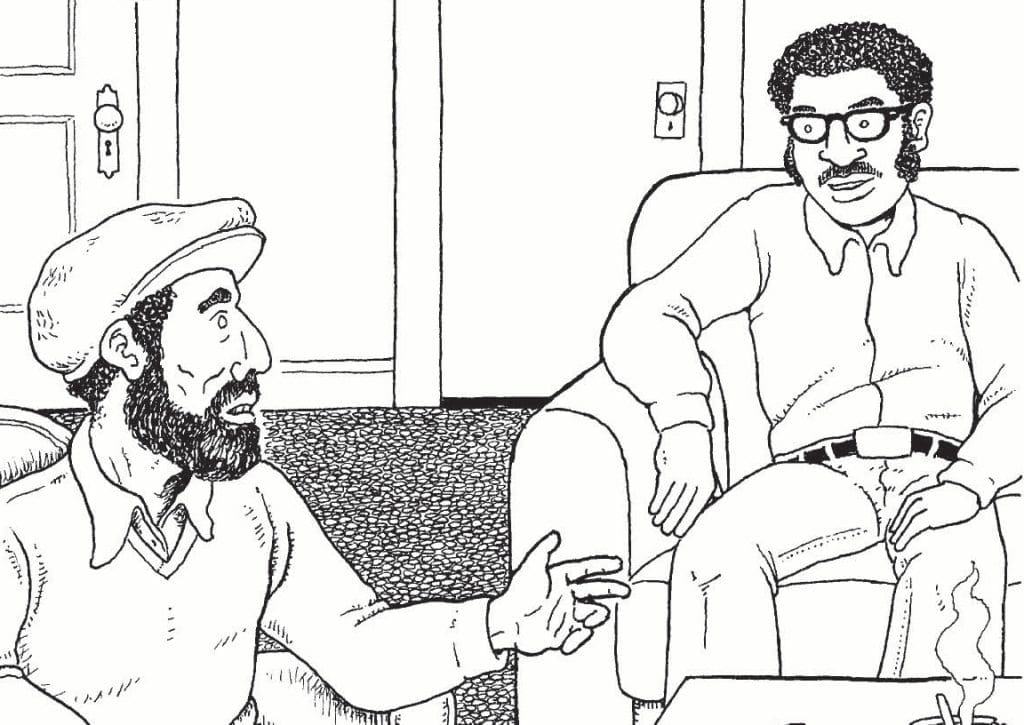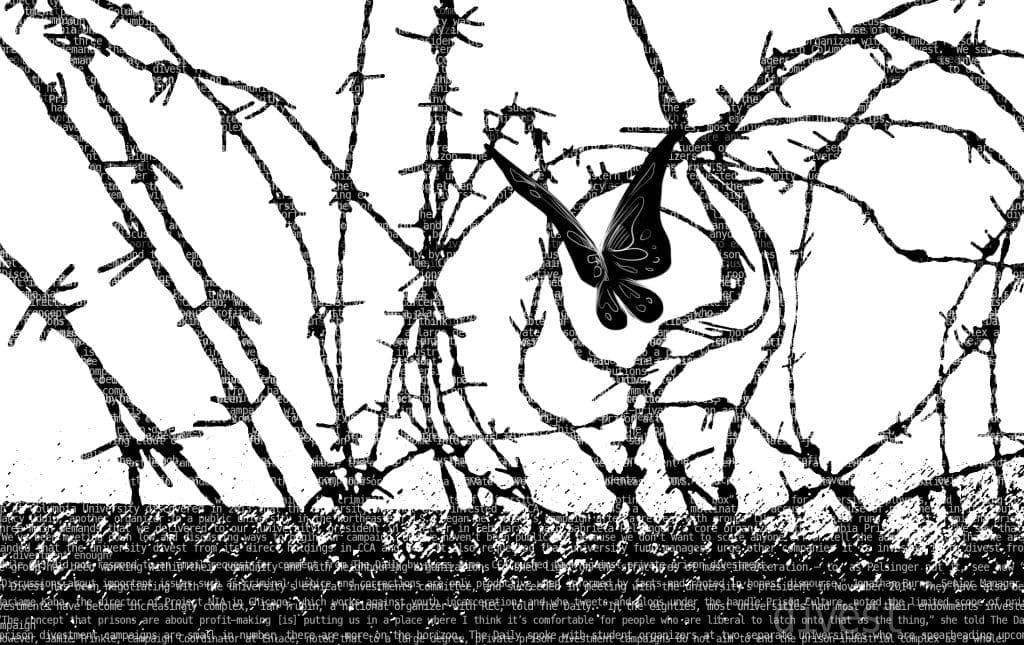AntiNote: The following is an extended excerpt of a radio interview, edited for readability.
On 12 April 2014, Chuck Mertz of This is Hell! Radio (Chicago) talked to activist, educator and author Paul Buhle about bohemians.
Perhaps mainstream discourse has already wrung every last drop of usefulness from the topic of “bohemians” (or “hipsters,” or whatever term we’re using for this amorphous subgroup of people)—it has become as much of a cliché as “fratboys” when trying to shoehorn people into categories. But sometimes much more vital questions are embedded in these discussions, like those of gentrification, right to the city, the aristocratization of creativity, and the convergence of art and radical activism.
We find Buhle’s perspectives on some of these questions to be of particular interest because in some cases they contradict our own current understanding—and are based in large-scale historical thinking that demands to be taken seriously.
We invite your guidance on ways to extend some of Buhle’s thinking—for instance, he appears to want to carry his theories into the world of hip-hop (music the Antidote Writers Collective regards as an essential motor, recently, of both cultural and political change) but avoids doing so for lack of expertise on the subject. How can some of what Buhle says about jazz be applied to present-day contexts?
Also, what do you make of his apparent apologism regarding the oft-alleged connection between ‘bohemian’ cultural production and subsequent gentrification? How could this inform the way we conduct community struggles that have heavy countercultural components (for example, housing justice and squatting) and are frequently accused of propelling the very forces they avow to resist?
Buhle’s explanations contain a lot of fascinating historical detail. In this spirit, we’ll send you into this conversation with a (hopefully also fascinating) nugget of our own. At one point Buhle describes gentrified real estate as ‘gold-coast property.’ The origin of this expression—perhaps—is in the rapid and dramatic gentrification of Zürich’s historically bohemian Seefeld neighborhood in the 1970s. Seefeld lies along the eastern shore of Lake Zürich, which is surrounded by high ridges, and is part of what is known as the Gold Coast because of the evening sunlight it gets when the opposite shore is already in shadow. Gentrification on the Gold Coast—its being turned into proper ‘gold coast property’—arguably led to the famous Zürich youth movements of 1980 and beyond, as the “bohemians” began to angrily demand cultural space in a city they described as iced-over.
So, without further ado:
Chuck Mertz: On the line with us right now, live from Madison, Wisconsin: Paul Buhle, co-author of the new book Bohemians: a Graphic History. Good morning, Paul.
Paul Buhle: Good morning.
CM: Great to have you on the show. Paul is formerly a senior lecturer at Brown University, and currently produces radical comics. He is a former member of Students for a Democratic Society; he founded the SDS journal Radical America as well as The Oral History of the American Left. He is co-author, with Mary Jo Buhle, of The Encyclopedia of the American Left.
Let’s just start there. This is a little bit off-topic from bohemians, but you’ve written extensively on the history of the Left. Last month we talked with Adolph Reed about his essay Nothing Left in Harper’s. Since then, we’ve been having a running discussion about the Left, whether there is one.
You’ve studied the Left and counterculture, and clearly bohemians as well. Today, is there a Left? And does the existence or absence of an energized Left—or an apathetic Left—have an impact on whether there are bohemians?
PB: That’s a very difficult question. I retired to Madison, Wisconsin in 2009, and therefore was very much a part of the uprising of 2011, in which on any given day—although Madison has only 200,000 residents—there were 125,000 people in the street protesting the governor and his misgoverning. To say that this was part of an organized—let alone Marxist or Anarchist—Left would be a little silly.
But on the other hand, that it was a forceful group of working people—especially women healthcare workers and women teachers—was good evidence (like Occupy, nationally) that there are hundreds of thousands of people eager to do something not only to stop the downward slide, but also to point towards a reconstruction of society. What’s true here is even more true in various anti-austerity movements in Europe and other parts of the globe.
So in a sense, and for many historical reasons, the organized Left as it was known in the 19th century—in the U.S., largely an immigrant movement after the Abolitionist era—and the mid 20th century, and on into the 1960s and 1970s under the flag of the New Left, and then the anti-nuclear movement, and the movements in support of revolutions abroad, etcetera…all of this suggests that a revival is always possible.
But the conditions are very different, and the old kind of movement—based upon daily newspapers, weekly newspapers, groups calling themselves socialist—is just more problematic.
Which really leads us to bohemianism. The origins of so-called ‘bohemianism’ go back to the defeat of the French uprising of 1848. Once the uprising was crushed, there was a disinterest in the government—or a hostility toward the government—by thousands of young people, living in the Left Bank, principally: artists and other people who dressed in clothes they got from old clothing stores and involved themselves in free love, artistic experiments, and other sorts of things that seemed so fascinating to other Europeans near and far—those that could travel to Paris and observe this bohemian scene were intrigued by it, and admiring of it and envious of it.
That bohemian scene moved to various places around the world, but most famously it moved to Greenwich Village in the early part of the 20th century, just a hundred years ago. And there sprouted all kinds of new experiments in art, experiments in free love—heterosexual and homosexual and bisexual—and birth control movements, and all kinds of things that were opening up new territories for ideas of human freedom.
Greenwich Village sort of fades, in the light of rising rents and various other things, but by the ‘30s, ‘40s, and ‘50s we have a proliferation of artistic and lifestyle experiments—and I should include the 1920s, because that was the era of the Harlem Renaissance. There’s no question among scholars of bohemianism that modern jazz is part of this scene, that abstract experimental painting is part of this scene, that the Beat Generation is part of this scene, and that the counterculture as it emerges in the middle 1960s is the heir to this scene—and likewise so would be punk music and phenomena that continue right up to this day.
Bohemianism minus an organized political Left occupies a space in which people, young people in particular, experiment in various kinds of social forms and try to find something for themselves until a new world can arrive.
CM: Do you think that there is, then, a connection between the Left and bohemianism?
PB: In my own experience—being born in central Illinois in the middle 1940s and coming of age down in those conservative districts in the middle 1960s, and other places in the late 1960s—I saw politics and culture go side by side. A rebellion in one was a rebellion in the other. It had a lot to do with the generational rebellions, but it had to do just as much with disillusionment with the war in Vietnam and an unwillingness to go and fight—kill or be killed—in Vietnam.
But it was clear that the politics of social movements were not going to be separated from the culture of social movements. So my view of today is that, culturally, we’re in a very fertile position for a return of social movements; we’re sort of waiting for a signal, or waiting for a way to organize, resisting the destruction of public schools, resisting further U.S. foreign policy adventures—which always seem to be just around the corner—but at the same time finding a way to stitch diverse constituencies together.
“I think there are reasons why Park Slope in Brooklyn became gentrified twenty years ago, but I don’t think it was the presence of the artists; it was the presence of the brownstones.”
CM: You mentioned pricing people out of Greenwich Village.
PB: A new subway line to Sheridan Square opened in 1921, and rents in Greenwich Village shot up immediately. The same story has happened repeatedly. At that time it was declared in popular magazines that bohemianism was now dead. That’s been declared more times than you can imagine. But, as with talk about the devastation of New York’s Lower East Side—which has been declared dead dozens of times—it never quite turns out to be true.
CM: If we price out bohemians from places like Manhattan, which is seen as one of the cultural centers of the United States, if not one of the cultural centers of the world, what is the impact to the creative industry? What happens when there is suddenly a geographical or an economic disconnect between bohemian culture and the creative industries in this country?
PB: Well, historically speaking, they move to Brooklyn. For every big bookstore that closed in Manhattan in the last five or ten years, a new, smaller bookstore opened in Brooklyn. Artists will migrate—a none-too-grand affair—to live in some cheaper neighborhood, and the important question is, do they find a neighborhood in which they share a lot with other artists or other people who are like-minded? My feeling is that relatively speaking, they very often do. My optimistic view is that, like musical bands, artists who are determined to go ahead will find a way to go ahead.
CM: Whenever bohemians come up on the show, I remember an interview we did with Rebecca Solnit way back in 1999. We talked about her new book at that time, Hollow City, and its discussion of San Francisco gentrification. Rebecca described bohemians as urban pioneers who unwittingly stake out ground, eventually, for gentrification. To what degree are bohemians pawns for developers?
PB: Well, the Bay Area is a pretty unique case, because it’s been a magnet for generations. When I was 18 years old, I left Champaign, Illinois on a Greyhound bus and ended up in San Francisco, because I’d heard the beatniks were there.
In a great many places in the United States, the gentrification is slow, uneven, or it doesn’t happen where you are. So I wouldn’t generalize grandly. I think there are reasons why Park Slope in Brooklyn became gentrified twenty years ago, but I don’t think it was the presence of the artists; it was the presence of the brownstones.
So I take Rebecca Solnit’s point, and it may be that there are places in Oakland that are now being gentrified, but the only ones that I know of are in Oakland by accident, when they should be in Berkeley. I’m not aware of all the new neighborhoods that bohemians have staked out and have become ‘gold coast’ properties.
CM: You write in Bohemians: “the danger that they pose for the fretful of every generation since the 1850s is also the secret of their lasting appeal—in particular to the disaffected and the young. They seem to lead the feckless or merely naïve and especially artistic-minded youth toward wrack and ruin, morally if not physically. They disregard existing laws, especially those connecting love and marriage; they belong to no clear or certain social class; yet they continue to be the transgressive class.” By transgressive you mean they violate accepted or imposed boundaries, especially those of social acceptability.
So do they cross all demographics? We had a discussion on our show about the idea that a rich American has more in common with rich people from other nations than they do with other Americans who are not at the same economic level that they are. Could the same be said for bohemians? Do they have more in common with other bohemians—no matter where they live in the world—than they do with people from their own country?
PB: Well, that’s a very interesting question, because the relative social freedoms that were normal in Scandinavia, for instance, 60 years ago—people casually living together or engaging in serial monogamy, etcetera—didn’t come to the U.S. until 30 years or more later. So you can ask that question in different sorts of ways, and you’re likely to get different sorts of answers. But what I would say about bohemians historically is that things like interracial dating and interracial marriage were really a province of bohemia and the Left, especially in the 1940s and 1950s in the U.S.
It was illegal to marry in a number of places, California included—not only the deep South—and transgressing this was deeply associated with the American Left. The larger milieu around the Communist Party was such that whenever there would be a mixed-race couple together walking down the street, people would taunt them by saying, “hello, comrades.”
“Without Parisian bohemianism, there’s no place for Josephine Baker.”
If we go down to later decades and into the present, where the number of women who choose to live with a man or not to live with a man, or have children outside of a ‘normal’—supposedly normal—relationship: that has broadened in massive terms. Very large numbers of people, much larger at younger ages, have made that decision. Men as well as women. For me, this is a legacy of bohemianism. And it penetrates all kinds of social groups where the word bohemianism isn’t very much present.
But I believe if you travel to Latin America, parts of Asia, certainly across Europe, there will be people who think of themselves as bohemians—especially people who are under the age of 30—and they probably do have a lot in common with each other.
CM: Often the stereotype of a bohemian is somebody who is lazy, who is unproductive, and who is also from a privileged elite; they might have some trust fund that’s paying for their whole ride. That’s the image that we have. In Bohemians you point out the role of African Americans within bohemianism. What do we miss in understanding bohemianism when we only think of bohemians as privileged elites who are lazy and don’t contribute to society?
PB: I’m no great expert on modern jazz, but it’s obvious to anybody that the fan base—which was most definitely biracial—for modern jazz, from the mid-40s, created a space for black musicians from deeply impoverished families to make their way, make a poor living, and make themselves internationally famous.
Without Parisian bohemianism, there’s no place for Josephine Baker. She was chased off by the Red Scare, and there hardly was a place for her in the U.S., but she’s the emblematic figure of bohemianism and what it opened up for some very, very vital and influential people of color. I’m thinking the same thing is true today in a number of spheres, but I don’t claim to be an expert in them.
CM: Are all bohemians luddites?
PB: That’s a very good question. Someone said sneeringly that any 21-year-old who can use software and create ideas about comics or music or something and calls herself or himself a bohemian: that person is subjecting the great truths of bohemianism to a form of corruption. This would be a typical thing for a grumpy 55-year-old to say, an ex-bohemian who probably has a condo and now can look back upon their glorious bohemian past.
So the question is, can anybody be a bohemian? And the answer is in the vague definition bohemianism has always had: the substitution of art and creativity for a career and making money. Some people, necessarily or unnecessarily, make a huge compromise in that regard and end up as what we think of as kitsch artists. But others make the compromise successfully; there was an awful lot of good creative work in Hollywood in the ‘30s and ‘40s before the blacklists came.
But others are artists in the garret, today as they were more than 100 years ago. On the web, comics manage to produce a whole lot of stuff because they can make it available free. It doesn’t necessarily mean that they will ever get money or recognition from anybody. But it does open up new avenues—for young people in particular—to create art and see how people will respond to it.
“The Bohemian immigrants to Chicago and Cleveland, two big centers where they settled, were linked with Chicago anarchists…who were themselves a very bohemian bunch in the 1880s.”
CM: How about this? Can you be a rightwing bohemian?
PB: Historically, some bohemians were total individualists that held a sort of individualist anarchist view. They hated everything: they hated the government, they hated business. Sometimes they sounded like monarchists. One fellow from Idaho, Ezra Pound, became the leading poet of the 20th century—and he leaned toward fascism. Later he told Alan Ginsberg he’d been wrong about everything, including his antisemitism; he was always rebelling in the wrong direction.
I suspect that people who call themselves paleo-conservatives—that is, they oppose U.S. foreign policy but at the same time don’t believe in state control of anything whatsoever—they come as close to being rightwing bohemians as anyone I’ve known. But let me say that rightwing bohemians are a rarity.
CM: Why this format? You did Studs Terkel’s Working as a graphic novel. Now here is a history of bohemians as a graphic novel; you’ve also done Wobblies: a Graphic History of the Industrial Workers of World, Jews and American Comics: an Illustrated History of an American Art Form, Students for a Democratic Society: a Graphic History, Robin Hood: People’s Outlaw and Forest Hero, a Graphic Guide. Why write in this format? And do academics scoff at you for presenting history in this format?
PB: Well, when I was in my later years as a professor, I realized that I was writing articles, and sometimes books, that were read mainly—and often resentfully—by graduate students. It wasn’t like undergraduates were going to read them. And I thought, boy, I’ve got to think of another path here.
And then I recalled that my sister, being four years older than me, had taught me how to read for the first time through comic books, and that my childhood hero had been the founder of Mad comics, Harvey Kurtzman, and that comics had reentered my life in 1969: when I produced Radical America Comics for Radical America magazine, it was the most successful issue of any magazine I ever published.
And comics became a way of returning to my own themes. The Beats has plenty about Chicago, and the Beats of Chicago from the ‘30s to the ‘50s. Working really has to do with me teaching Studs Terkel to oral history students, and how Studs Terkel is the only real great figure in the whole field of oral history, and what he’s meant to all of us. Bohemians maybe relates to visiting Hyde Park when I was fifteen years old. Even Wobblies: a lot of it is about Chicago; it was basically by a kid from Champagne in Chicago, trying to understand what this great big scene is. So I must confess that these were topics that were terribly important to me as I was growing up and making sense of a world of civil rights, of the antiwar movement, of the Beats in between, and trying to see how one could connect with this in a useful and creative way without actually having any artistic talent at all.
CM: Paul, one last question for you. Our last question for each of our guests is the Question from Hell, the question we hate to ask, you might hate to answer, or our audience is going to hate your response.
I am ethnically Bohemian. My great-grandfather and great-grandmother came over from Bohemia. My grandmother was born in Detroit, but she was raised in a Bohemian household. It was a very tough time for these people who had just come over, and they faced a lot of racial discrimination. Once she got married to my grandfather, he would never allow her to speak (he would call it) “that dirty gypsy language” in the house.
My grandmother was Roma. Very dark-skinned woman. And so whenever I would hear the term bohemians when I was a kid I thought, wow, I should be like them, because I’m Bohemian.
So how did bohemians get to be ‘bohemian,’ and is the use of the term bohemian in a way racist towards Roma?
PB: There are several different ways of looking at this, and we would exhaust all of our time if we took all those ways.
You know, the first wave of the radical Reformation happened in England in 1381 with the rebellion of Wat Tyler. But the second wave begins in Bohemia with a revolutionary uprising. And ever after that, when the Roman Church re-imposed its will over Bohemia, there was a very, very strong resistance against Catholicism, and it took the form of what’s called Freethought. Not even anti-religious, not Protestant, but Freethought in the sense that you didn’t just accept the religion that was imposed upon you.
It didn’t happen only in Bohemia; many Scandinavians felt the same way about the Lutheranism imposed upon them, and for the same reason: church rule was connected with state rule. But there is this tradition, going back to the radical Reformation, of Bohemians saying No, absolutely not.
That’s something that may have come over with the Bohemian immigrants to Chicago and Cleveland, two real big centers where they settled. They were called bohunks and likened to Poles having big shoulders and short necks, and were known to be lumber-shovers in Chicago. But they were linked with the Chicago anarchists who were, in many cases, a very bohemian bunch in the 1880s.
A second part of the question is how did La Bohéme—which really set the operatic note for the use of the word bohemian—come to Paris in 1850, and why? “Gypsies” were believed to be centered—or at least lived in large numbers—in Bohemia, and supposedly “gypsy-like” behavior like easy living and easy loving seemed to characterize the young Parisians in La Bohéme, though they had neither any connection with the Roma nor any known connection with Bohemia.
But Murger, the creator of the novel Scénes de la vie de bohéme [upon which Puccini’s 1896 opera is based], seemed to provide the label that detractors of these Parisian “gypsies” were looking for, and they would call them bohemians. So it’s a fascinating confusion. It’s a double or triple confusion. Bohemians, the cultural rebels, got stuck with—or enjoyed being stuck with—that label as of 1850, and it never went away. And if you look on the web under bohemians, you’ll see the confusion exists until this very day. The only way I make the differentiation is with a small b and a large B.
CM: Paul, it has been a pleasure and an honor having you on the show this morning.
PB: So long, Bohemian!
Transcribed and printed with the permission of This is Hell! Radio. Listen to the full interview here:
Image: from Portland’s Black Panthers by Khris Soden and Sarah Mirk (Graphic History Collective)






Pingback: 795: Liquidity Trap | This Is Hell!
Thanks for letting me know about this great interview. I’m so grateful for the opportunity to interview Paul myself. We covered the subject a little differently so it’s nice to compare.